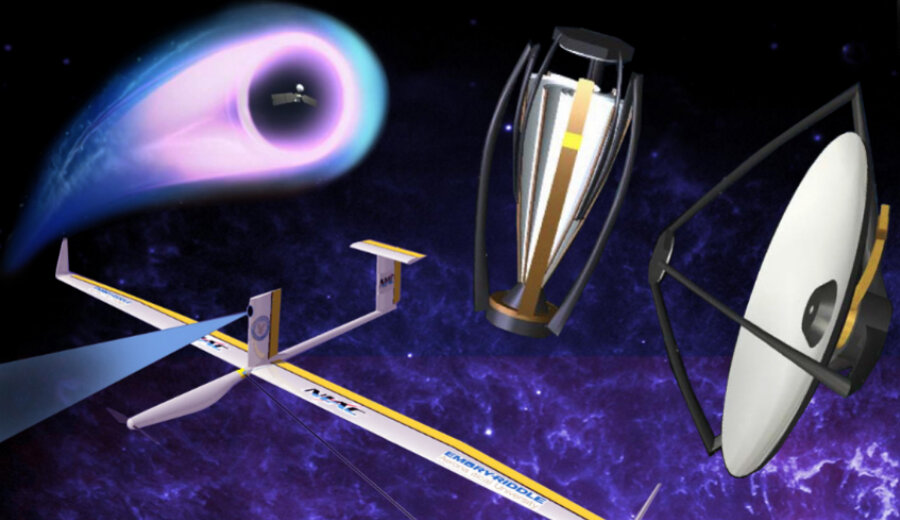NASA picks eight innovative tech projects to fund for future
Loading...
The future is now for eight technology innovators whose projects were selected for funding through the NASA Innovative Advanced Concepts (NIAC) program this past week.
The NIAC funding was granted to proposals "that have the potential to transform future aerospace missions, introduce new capabilities, and significantly improve current approaches to building and operating aerospace systems," according to the agency.
During this second phase of the program the developers could each be awarded up to $500,000 to launch a two-year study, which NASA hopes could eventually lead to improvements of its own operations as well as contributing to advances in aerospace and other fields of science.
"The NIAC program is one of the ways NASA engages the US scientific and engineering communities, including agency civil servants, by challenging them to come up with some of the most visionary aerospace concepts," explained NASA Space Technology Mission Directorate associate administrator Stephen Jurczyk in an agency release. "This year's Phase II fellows have clearly met this challenge."
Concepts ranging from space travel to observation tech were subjected to a peer review process before being named the 2016 award winners, and include:
- Growable human habitats to be built robotically in space, submitted by Texas A&M Engineering Experiment Station researcher Robert Skelton. The rotating structure would be held together using the principles of tensegrity, and would provide its occupants with a level of gravity, protect them from radiation, and be capable of growth in space.
- A massive space telescope that would eclipse the large-scale mirrors of the James Webb Space Telescope. A Precise Extremely large Reflective Telescope Using Reconfigurable Elements (APERTURE), submitted by Northwestern University professor Melville Ulmer, would launch with a compressed, membrane-like mirror that would expand to form and full size once in space.
- Torpor state stasis chambers submitted by John Bradford, president and chief operating officer of SpaceWorks Enterprises, Inc. The "advanced habitat system" could be used for the transportation of humans from Earth to Mars, and potentially beyond, by keeping its crew in a hibernation-like condition through their journey through space.
- A magnetized aerocapture system for landing on planets - including Neptune and Mars – designed to slow spacecraft down as they pass through cosmic bodies' atmospheres. Using magnetized plasma, the aerocapture concept would provide drag during descent as well as eliminate excess heat from friction. The "Magnetoshell" was proposed by MSNW, LLC propulsion research scientist David Kirtley.
- A twin glider atmospheric satellite designed by Embry-Riddle Aeronautical University mechanical engineering professor William Engblom. The Dual-Aircraft Platform (DAP) would consist of two glider-like craft in the lower stratosphere connected via a cable, propelled only by wind and solar power. The unmanned DAP could provide for low-cost and low-energy communications and monitoring services.
- An ultra-reflective novel coating dubbed "Solar White" that could theoretically repel 99.9 percent of solar energy. After manufacturing the coating, NASA Kennedy Space Center physicist Robert Youngquist - who submitted the NIAC bid for Solar White – will test the substance on surfaces for potential uses such as extended cryogenic storage units and high temperature superconductivity.
- Plasmonic force propulsion systems to better control the orientation of nano- and picosatellites. Missouri University of Science and Technology associate mechanical and aerospace engineering professor Joshua Rovey's proposal could provide very fine maneuverability for future NASA nanosatellites with a minimal toll on the crafts' operations.
- The study of directed energy for use in future interstellar travel. University of California, Santa Barbara physics professor Philip Lubin's investigations could provide a base for the development of propulsion systems that could send craft – manned and unmanned – farther and faster through the cosmos than ever before, as well as laser communications to stay in contact with the rapidly moving space vessels.
The full list of 2016 Phase I and II selections and related details is available online.
This marks the sixth year of NIAC selections since NASA revamped the former Universities Space Research Association-managed NASA Institute for Advanced Concepts, which was shuttered in 2007. Over its nine-year run, the original NIAC awarded more than 160 grants and contracts culled from more than 1,300 proposals, and invested a total of $27.3 million aimed at concepts that would have a major impact on NASA operations up to 40 years down the line.
The new NIAC, established in 2011, has continued to provide awardees with the resources to work on developing the technology of the future across 15 subject areas including propulsion systems, communications, nanotechnology, human life support, and more. So far, the NIAC revival has supported more than 130 projects, with 21 this year, including the newly announced group of Phase II selections.
"Phase II decisions are always challenging, but we were especially challenged this year with so many successful Phase I studies applying to move forward with their cutting-edge technologies," NIAC program executive Jason Derleth said in the NASA statement. "I'm thrilled to welcome these innovations and their innovators back to the program. Hopefully, they will all go on to do what NIAC does best – change the possible."
All of the NIAC projects are long-term investments; NASA does not expect the new concepts to come to fruition for at least a decade, if not later.
NASA will begin soliciting for next year's NIAC Phase I submissions in August.






